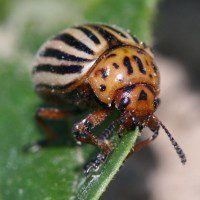
Dr. Mitchell Baker
Assistant Professor
Ph.D., University of California at Davis
Office: NSB D-324 Tel: (718) 997-3425
Laboratory: NSB D-315/317 Tel: (718) 997-3404/3405
E-mail: Mitchell.Baker @ qc.cuny.edu
I study how behavior, primarily movement, acts as a mechanism underlying population phenomena such as extinction or local adaptation. My life in science began as an interest in drawing birds, which led to study of clutch size, life history evolution, and eventually dispersal in birds, and now mostly involves working with arthropods. A primary question in my lab is how movement and other behaviors shape the evolution of resistance to insecticides. A principal method to slow the evolution of resistance to insecticides is the use of untreated or alternately treated refuge fields to dilute the genes for resistance in treated areas. Successful refuge design depends on an understanding of the movement controlling gene flow between refuges and treated areas, which we are measuring both directly and indirectly.

A cline is a geographic transition where a trait goes from low to high frequency or vice versa. Clines result from the opposing forces of selection and movement, with a narrow cline for example resulting from strong selection on opposite sides, little movement between sides, or both. In collaboration with Adam Porter at University of Massachusetts and Andrei Alyokhin at University of Maine I create and analyze clines in insecticide resistance within individual fields to measure movement and gene flow in Colorado potato beetle, Leptinotarsa decemlineata. This project involves multiple lab and field components, including measurements of life history and behaviors that influence gene flow and resistance evolution, such as mating and sperm competition, behavioral responses to insecticides, and cannibalism. Spatial variation in selection due to insecticides should also change the costs and benefits of dispersal, which was the subject of my earlier work on natal dispersal in desert isopods, Hemilepsistus reaumuri, in the Negev.

Every spring desert isopods range from meters to kilometer in search of sites to start or gain access to burrows. Traveling isopods suffer high mortality and risk dehydration. Habitat selection alone does not justify their lengthy travel, but competition for entry to successful burrows from the previous season may. Previous experience modifies isopod settling decisions; isopods forced to spend time in unfavored habitat are less choosy about where they settle than those who have spent time in preferred habitat. Models of learning during natal dispersal show that this kind of effect of experience on dispersal can shape population dispersal patterns in the face of habitat loss or change, and this is a subject of continuing study, along with navigation and path integration in isopods.
I usually combine experimental and modeling approaches. I encourage collaborations with others involved with diverse natural systems, which have included Namib dune spiders that live in aggregations of burrows and trap ants on the surface, differentially migratory birds (where different age or sex birds overwinter in different areas), jumping spiders, coastal songbirds, and others.
Selected Publications:
Baker, M. B., and A. H. Porter. 2008. Use of sperm precedence to infer the overwintering cost of resistance in Colorado potato beetle. Agricultural and Forest Entomology 10: 181-187.
Sharp, S. P., M. B. Baker, J. D. Hadfield, M. Simeoni and B. J. Hatchwell. 2008. Natal dispersal and recruitment in a cooperatively breeding bird. Oikos 117: 1371-1379.
Alyokhin, A., M. Baker, D. Mota-Sanchez, G. Dively, and E. Grafius. 2008. Colorado potato beetle resistance to insecticides. American Journal of Potato Research 85: 395–413.
Baker, M. B., S. R. Dastur*, T. Wong* and B. D. Jaffe*. 2008. Mating competition between Colorado potato beetles (Coleoptera: Chrysomelidae) resistant or susceptible to imidacloprid does not show cost of resistance. Annals of the Entomological Society of America 101: 371-377
Baker, M. B. Use of experience, habitat selection, and dispersal: From individuals to populations. In Press , Evolutionary Ecology Research
Baker, M. B. Baker, M. B. 2005. Experience influences settling behavior in desert isopods, Hemilepistus reaumuri. Animal Behaviour 69: 1131-1138. PDF here
Baker, M. B., Alyokhin, A., *Dastur, S. A., Porter, A. H., and Ferro, D. N. 2005. Sperm precedence in overwintered Colorado potato beetle (Coleoptera: Chrysomelidae) and its implications for insecticide resistance management. Annals of the Entomological Society of America 98: 989-995. PDF here
Baker, M. B. 2005. Path integration in humans. In Laboratory and Field Exercises in Animal Behavior: Learning the Skills of Research , Sinauer: Sunderland, MA.
Baker, M. B., and S. Rao. 2004. Incremental costs and benefits shape natal dispersal; theory and an example using desert isopods, Hemilepistus reaumuri. Ecology 85:1039-1051. PDF here
Baker, M. B., A. Zemel. 2000. Josef Bertrand catches some ants: An unbiased algorithm for the simulation of the entry of individuals into an arena. Journal of Theoretical Biology 207: 299-303. PDF here
Baker, M., N. Nur, and G. R. Geupel. 1995. Correcting biased estimates of dispersal and survival due to limited study area: Theory and an application using Wrentits. The Condor 97: 663-674. PDF here
Baker, M. 1995. Environmental Component of Latitudinal Clutch Size Variation in House Sparrows (Passer domesticus). The Auk 112: 249-25
List of Publications from PubMed
Here are my graduate students:
Kathleen Schnaars kathleen.schnaars@qc.cuny.edu
Karyn Collie karyn.collie@qc.cuny.edu

